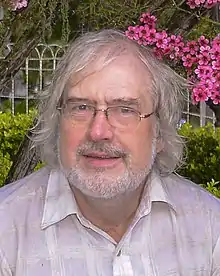John Harrison Wharton
John Harrison Wharton (21 September 1954 – 14 November 2018) was an American engineer specializing in microprocessors and their applications. Wharton designed the Intel MCS-51, one of the most implemented instruction set architectures of all time.
John H. Wharton | |
|---|---|
 | |
| Born | September 21, 1954[1] |
| Died | November 14, 2018 (aged 64)[2]
[1] Redwood City, California, USA |
| Alma mater | |
| Engineering career | |
| Discipline | |
| Employer(s) |
|
| Significant design | Intel MCS-51 |
| Website | www |
Education and career
John Wharton graduated from Northwestern University with a Bachelor's degree in electrical engineering in 1976 and a Master's degree in computer science in 1977, having earlier attended Yale University for two years before transferring to Northwestern.[3] He was hired by Intel at the instigation of Tom Rolander,[4] working there for 5 years before leaving to start his consulting company, Applications Research.[3] He was a founding member of the editorial board of Microprocessor Report.[5] He first spoke at the Asilomar Microcomputer Workshop in 1980, along with Carver Mead, Jim Clark, Dave Patterson and Gary Kildall.[6] He first chaired a session in 1983, and became Chair of the workshop in 1985, a position he continued to hold through 1997. He was Program Chair from 1999 through 2017.[6] From 1989 to 2004, with Dennis Allison, he coordinated Stanford University's EE380 course.[7]
J. H. Wharton was the architect of the instruction set of the Intel MCS-51,[3] commonly known as the 8051. The MCS-51 and its derivatives are Intel's highest volume microprocessor,[8] and among the most implemented instruction set architectures of all time.[2][3]
Wharton was the subject of a 1999 New York Times profile,[8] and a 2001 article about his trips to Fiji to collect debris from the deorbit of the Mir space station.[9] In 1996 he appeared on Late Night with David Letterman.[8][10] His friends have created a memorial Web site.[11]
References
- "John Wharton", San Jose Mercury News, December 6, 2018, retrieved December 6, 2018
- Orlowski, Andrew (November 19, 2018), "Influential Valley gadfly and Intel 8051 architect John Wharton has died", The Register, archived from the original on November 19, 2018, retrieved November 28, 2018
- Intel 8051 Microprocessor Oral History Panel (PDF), Computer History Museum, September 16, 2008, archived (PDF) from the original on February 25, 2012, retrieved November 17, 2018
- Legacy of Gary Kildall: The CP/M IEEE Milestone Dedication, Computer History Museum via YouTube, April 25, 2014, archived from the original on August 1, 2014, retrieved November 21, 2018
- Slater, Michael (August 25, 1997), "Looking Back on Ten Years of MPR: Personal History of MicroDesign Resources" (PDF), Microprocessor Report, archived (PDF) from the original on October 3, 2018, retrieved November 17, 2018
- Programs from the Asilomar Microcomputer Workshop 1975-2018 (PDF), Asilomar Microcomputer Workshop, April 25, 2018, archived from the original (PDF) on August 18, 2018, retrieved November 17, 2018
- Wharton, John (July 22, 1998), The Chip that Wouldn't Die: A 20-Year Retrospective, Stanford University, archived from the original on November 18, 2018, retrieved November 17, 2018
- Hafner, Katie (June 17, 1999), "Reinvent the Wheel? This Software Engineer Deconstructs It", New York Times, archived from the original on May 27, 2015, retrieved November 17, 2018
- Markoff, John (April 24, 2001), "My Fiji Souvenirs: Shells, Driftwood, Space Debris . . .", New York Times, archived from the original on December 23, 2009, retrieved November 30, 2018
- Bay Area Man Relives Time He Disrobed On Late Show With David Letterman, KPIX-TV, May 14, 2015, archived from the original on May 19, 2015, retrieved November 18, 2018
- John H. Wharton, archived from the original on January 26, 2019, retrieved April 15, 2019